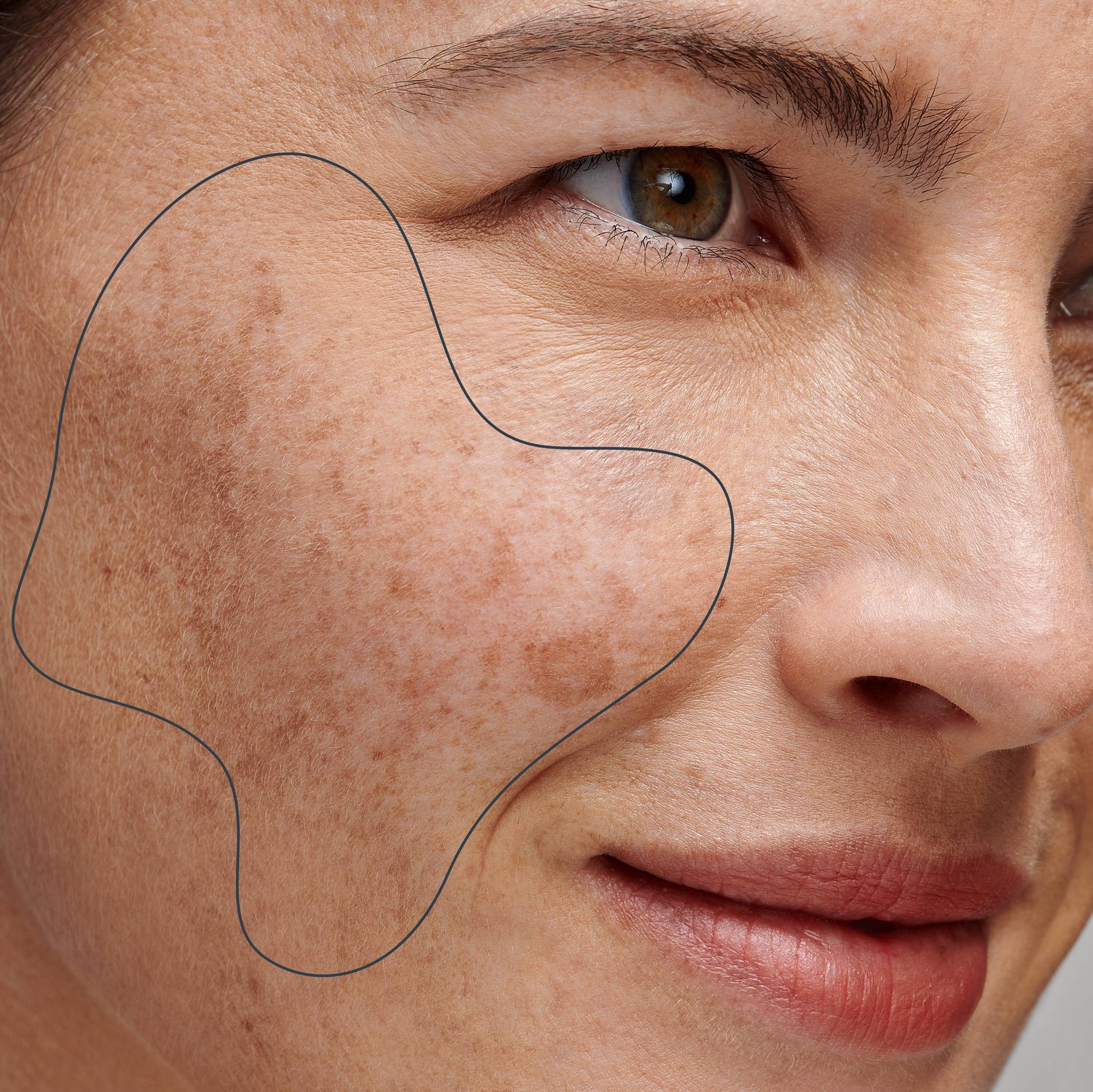"I wear makeup to help my skin look even".
Does this sound familiar?
Uneven skin tone and pigmentation (also called hyperpigmentation) is one of the main skincare goals we help clients with.
Whether it's from spending too much time in the sun, or post-breakout marks that are left on the skin, pigmentation is a concern that requires some understanding, as it's a very complex skin condition.
What is Pigmentation?
Pigmentation, or hyperpigmentation is what we call the dark spots or patches we may see on our skin.
These darker areas occur when the skin produces more melanin and can affect people of all skin types.
What is Melanin?
Melanin is the pigment that gives our skin its colour.
Some skins may naturally have more melanin (olive or darker skin tones) and some skins have less melanin (fair skin). Melanin can make dark spots or patches of the skin appear darker than surrounding areas.
Melanin is stimulated and formed to help protect our skin cells from further damage from UV. This protection extends to all forms of UV light (UVC, UVB, and UVA) as well as blue light. It does this by absorbing the UV light before it’s able to damage the sensitive DNA of the skin cells.
Melanin levels are generally determined by genetics, but they can be influenced by outside sources, such as sun exposure, hormones, medication, inflammation or even age.
The 3 main forms of Pigmentation
1. Melasma
Melasma is a type of pigmentation caused by hormonal changes that impact the production of melanin. These changes often develop during pregnancy or when using birth control.
It mainly appears on the forehead, cheeks and upper lip. These dark spots often look like patches or a mask.
Treating melasma can be difficult, as hormones influence the skin 24 hours a day.
2. Post-Inflammatory Pigmentation
This type of dark spot is a result of inflammation or injury to the skin e.g. from acne.
When a breakout has healed, the dark spot that is commonly left behind is what we call post-inflammatory hyperpigmentation.
Susceptibility to post-inflammatory hyperpigmentation does increase with age because our cell turnover slows down and it takes longer for these dark spots to move to the surface of the skin.
3. Sun Spots
The most common type of dark spots is related to overexposure to UV rays. They generally appear as dark spots on areas that are typically exposed to the sun eg hands, face, neck and chest.
What to expect when treating pigmentation
When we first start to tackle pigmentation, there are a few key things to take note of.
- Stimulants for pigmentation are constantly around us (especially when it comes to UV rays), so treating pigmentation is complex and the results will be different for each person. Be patient.
- There’s no quick fix for hyperpigmentation: it can take at least 30 days of consistent skincare treatment (with sunscreen use) before you see any progress.
- Some spots may look darker before they lighten; this is because they gradually rise to the skin’s surface as you continue to exfoliate. But stick with it, and you’ll eventually see brighter, firmer, more radiant skin!
Treating pigmentation effectively
A consistent home care routine is extremely important when targeting pigmentation. Your home care products should incorporate ingredients that not only smooth and brighten the skin, but target the prevention of pigmentation while treating the existing pigmentation Dermalogica's Powerbright range consist of 3 targeted products that work in synergy with each other at targeting pigmentation and uneven skin tone.
Dermalogica Powerbright
A daily spf and moisturiser in-one that shields the skin against dark spots and shields against free radical damage
- Niacinamide helps reduce the appearance of pigmentation
- Hyaluronic Acid and Safflower Oil provide continuous hydration to the skin to help strengthen the barrier and reduce the appearance of fine lines
- Brown Algae, Vitamin B6, B12 and Zinc help protect the skin against free radical damage from air pollution
Apply the Powerbright Dark Spot Serum and follow with the Powerbright Moisturiser SPF50
Advanced ingredient technology helps fade dark spots, smooth the skin and even the appearance of fine lines.
- Niacinamide and Hesylrescorcinol - Helps fade the appearance of dark spots
- Vitamin C delivers brightening and antioxidant properties
- Pumpkin Enzyme smoothes the skin and balances uneven skin tone
Apply every night to the face and neck area
Supporting the skin internally with Vitamin C
Powered by three ingredient technologies: Vitamin C, Zinc and Acerola Cherry in a daily dose vitamin capsule to help brighten dull-looking skin. By synergising these ingredients together, Skin Vit C offers an array of benefits to all skin types. This vitamin supplement is targeted to help dull skin, and those concerned with premature ageing, uneven skin tone and environmental aggressors.
- Stimulates an eight-fold increase in the synthesis of collagen
- Strengthens collagen
- Supports blood vessels
- Lightens and brightens the skin
- Photo-protective
- Anti-inflammatory
We are here at anytime if you need guidance and support around your skin concerns and what products are best for you. Please reach out to us for advice.
About the Author
My name is Sarah and I am the founder of GLO Skin Body. With almost 20 years experience, I believe a professional relationship with your skin therapist is crucial in helping you to achieve your skin care goals and to ensure your skin is always looking and feeling its best. Whether it's in person or through our online support, Im here to guide and support you towards your healthiest skin ever.
On a personal note, I am a Mum of 3 so I understand completely the juggles and balancing of life and family commitments . My goal is to help everyone have an effective and enjoyable home care routine that gets you the results you want...no matter how busy you are!





